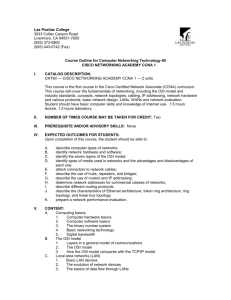Fundamentals of Voice and Data Cabling
advertisement
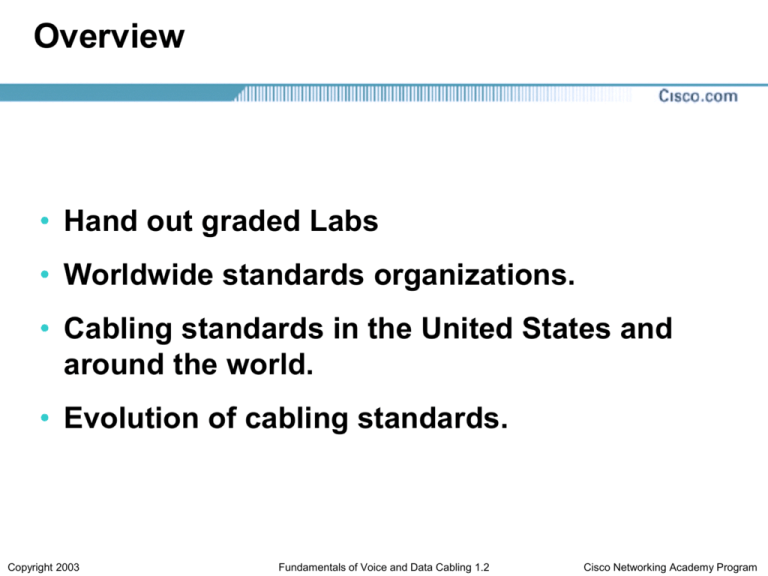
Overview • Hand out graded Labs • Worldwide standards organizations. • Cabling standards in the United States and around the world. • Evolution of cabling standards. Copyright 2003 Fundamentals of Voice and Data Cabling 1.2 Cisco Networking Academy Program Introduction to Cabling Standards and Codes • Codes promote electrical safety. • Electrical codes protect people from hidden hazards that may come to them from wiring that was done improperly. • A code provides a list of do’s and don’ts, which if followed, will ensure that serious problems are less likely to occur. • Codes also protect workers. Copyright 2003 Fundamentals of Voice and Data Cabling 1.2 Cisco Networking Academy Program What are Codes? Electrical codes are an attempt to provide the following: • Protection against electric shock. • Protection against fault currents, where misplaced voltages find paths to ground in unpredictable ways. • Protection against thermal effects of electric current. • Protection against overcurrent. • Protection against overvoltage. Copyright 2003 Fundamentals of Voice and Data Cabling 1.2 Cisco Networking Academy Program What are Standards? • Standards are sets of rules or procedures that are either widely used, or officially specified, and that serve as the gauge or model of excellence. • Standards can be specified by a single vendor or be industry standards that support multi-vendor interoperability. • Integrated cable plans developed by specific companies are called Structured Cable Systems (SCS). Copyright 2003 Fundamentals of Voice and Data Cabling 1.2 Cisco Networking Academy Program What are Best Practices? • Best practices are research-based ways of performing job functions known to assist users while performing tasks. • Installing a standards-based cabling solution causes the workers on the job to learn and use best practices. • Many of the standards cannot be followed without using them. • In fact, failure to follow with these best practices can severely limit the circuit's capability to deliver the specified performance. Copyright 2003 Fundamentals of Voice and Data Cabling 1.2 Cisco Networking Academy Program The Evolution of Standards • By the mid-1980s, there were many different network technologies. • The Open System Interconnection (OSI) reference model was designed to provide a set of standards that promoted compatibility and interoperability between the various types of network technologies that were produced by companies around the world. • Cabling technologies are included in Layer 1 (physical layer) of the OSI model. Copyright 2003 Fundamentals of Voice and Data Cabling 1.2 Cisco Networking Academy Program Standards Development Groups • The focus in this curriculum is on the standards for networking media that have been developed and issued by the following groups: • IEEE – Institute of Electrical and Electronics Engineers. • UL – Underwriters Laboratories. • EIA – Electronic Industries Alliance. • TIA – Telecommunications Industry Association. Copyright 2003 Fundamentals of Voice and Data Cabling 1.2 Cisco Networking Academy Program What are International, National, and Local Standards? • Organizations like IEEE, ISO, and IEC are all examples of international standards bodies. • At the national level, theses standards might be incorporated into one or more "codes" such as an electrical code, building code, or fire code. • In many countries, the national codes become the model for state/provincial agencies as well as municipalities and other governmental units to incorporate into their laws and ordinances. Copyright 2003 Fundamentals of Voice and Data Cabling 1.2 Cisco Networking Academy Program IEEE’s Standards • 802.3 -- Standards for carrier sense multiple access with collision detection (CSMA/CD) access method. This is basically the Ethernet standard. • 802.5 -- Standards for Token Ring access method LAN/MAN. • 802.8 -- Standards for fiber-optics technologies. • 802.11 -- Standards for wireless LAN connectivity. This is the technology behind Cisco and many other vendors’ wireless network initiatives. Copyright 2003 Fundamentals of Voice and Data Cabling 1.2 Cisco Networking Academy Program IEEE 802.3 Standards Copyright 2003 Fundamentals of Voice and Data Cabling 1.2 Cisco Networking Academy Program IEEE 802.5 Standards Copyright 2003 Fundamentals of Voice and Data Cabling 1.2 Cisco Networking Academy Program 802.11 Standards • The IEEE 802.11 standard allows for wireless transmission of data. Copyright 2003 Fundamentals of Voice and Data Cabling 1.2 Cisco Networking Academy Program ANSI/EIA/TIA Organization Copyright 2003 Fundamentals of Voice and Data Cabling 1.2 Cisco Networking Academy Program TIA/EIA Standards • TIA/EIA-568-B.1 – Commercial Building Telecommunications Cabling • TIA/EIA-568-B.2 – Commercial Building Telecommunications Cabling • TIA/EIA-568-B.3 – Optical Fiber Cabling Components Standard • TIA/EIA-569 – Commercial Building Standard for Telecommunications Pathways and Spaces • TIA/EIA-606 – The Administration Standard for the Telecommunications Infrastructure of Commercial Buildings – Specifically Labeling at BICSI Level 1 Installer • TIA/EIA-607 – Commercial Building Grounding and Bonding Requirements for Telecommunications Copyright 2003 Fundamentals of Voice and Data Cabling 1.2 Cisco Networking Academy Program American National Standards Institute (ANSI) • ANSI identifies industrial and public requirements for national consensus standards and coordinates and manages their development. • ANSI does not develop standards itself. Rather it facilitates development by establishing consensus processes among qualified groups. Copyright 2003 Fundamentals of Voice and Data Cabling 1.2 Cisco Networking Academy Program International Organization for Standardization (ISO) • ISO is an international organization composed of national standards bodies from over 140 countries. • American National Standards Institute (ANSI), for example, is a member of ISO. • ISO is a non-governmental organization established to promote the development of standardization and related activities. • ISO's work results in international agreements, which are published as International Standards. Copyright 2003 Fundamentals of Voice and Data Cabling 1.2 Cisco Networking Academy Program Other International Standards Development Organizations • ECA – Electronic Components, Assemblies, & Materials Association • CEA – Consumer Electronics Association • GEIA – Governmental Electronics and Information Technology Association • JEDEC – Joint Electron Device Engineering Council • NEMA – National Electrical Manufacturers Association • IEC – International Electrotechnical Commission Copyright 2003 Fundamentals of Voice and Data Cabling 1.2 Cisco Networking Academy Program Underwriters Laboratories Inc. (UL) • UL evaluates wire and cable products under more than 70 different product categories, utilizing more than 30 standards for safety. • UL has safety standards for cables similar to those of the NEC. • UL 444 – The standard for safety for communications cable. • UL 13 – The standard for safety for powerlimited circuit cable. Copyright 2003 Fundamentals of Voice and Data Cabling 1.2 Cisco Networking Academy Program Occupational Safety and Health Administration (OSHA) • OSHA is a federal program developed because of the wide disparity in work place safety standards and enforcement from state to state. • Its mission is to ensure safe and healthful workplaces in America. • OSHA is not a building code or building permit related agency. • OSHA inspectors have the power to impose heavy fines and/or shut down a jobsite for serious safety violations. Copyright 2003 Fundamentals of Voice and Data Cabling 1.2 Cisco Networking Academy Program NFPA and NEC • The National Fire Protection Association (NFPA) establishes the National Electrical Code (NEC). • The NEC specifies where various types of cables can be used within a building and the materials used in the cables. • The Canadian equivalent is the Canadian Electrical Code (CEC). Copyright 2003 Fundamentals of Voice and Data Cabling 1.2 Cisco Networking Academy Program NEC Article 800: Communications Circuits • This code must be followed when installing communications circuits and components. • This code details the installation requirements of copper cabling and copper cable components. • Article 800 also defines an array of requirements such as hanging communications wires on utility poles, for using primary and secondary lightning protection methods and systems, and what kinds of wiring can share raceways. Copyright 2003 Fundamentals of Voice and Data Cabling 1.2 Cisco Networking Academy Program National Fire Protection Agency (NFPA) • NFPA develops, publishes, and disseminates codes and standards intended to minimize the possibility and effects of fire and other risks. • Virtually every building, process, service, design, and installation is affected by NFPA documents. • More than 300 NFPA codes and standards are used around the world. • The NEC is part of the NFPA’s publication number 70 (NFPA-70). Copyright 2003 Fundamentals of Voice and Data Cabling 1.2 Cisco Networking Academy Program Building Codes • Contact local zoning departments for information on permit requirements. • To obtain copies of local or state building codes, contact the building official for the local jurisdiction. All of the basic building codes that are adopted throughout the United States can be purchased from the International Conference of Building Officials (ICBO). • Local codes always take precedence over state codes which take precedence over national codes. Copyright 2003 Fundamentals of Voice and Data Cabling 1.2 Cisco Networking Academy Program International Codes Covered • Canadian Electrical Code (CEC) • Japanese Industrial Standards (JIS) • Australian/New Zealand Standards (AS/NZS) • European Union Directives • Copyright 2003 Fundamentals of Voice and Data Cabling 1.2 Cisco Networking Academy Program Standards grow and change Telecommunications communications cabling standards evolve from lessons learned and best practices. These standards are also driven by trends of the industry such as the following current trends: • Convergence of voice, video, and data applications • Increasing bandwidth • Storage area networks • Broadband communications Copyright 2003 Fundamentals of Voice and Data Cabling 1.2 Cisco Networking Academy Program Cable changes • As network bandwidth has increased from 10 Mbps to 1000 Mbps and beyond, it has created new demands on cabling. • Older types of cable are often inadequate for use in the faster modern networks. • For this reason, the types of cabling used changes over time, and the standards reflect this. Copyright 2003 Fundamentals of Voice and Data Cabling 1.2 Cisco Networking Academy Program Category 6 and 7 • Category 6 and 7 are the newest copper cables available. • Category 7 technology is not yet ratified. Category 6 Cable Copyright 2003 Category 7 Cable Fundamentals of Voice and Data Cabling 1.2 Cisco Networking Academy Program
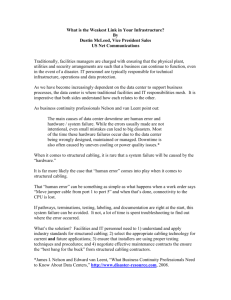
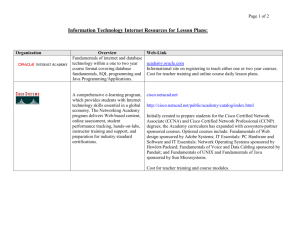
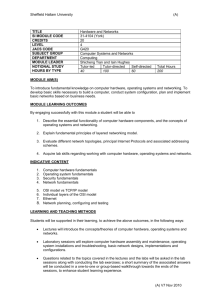
![Computer Networks [Opens in New Window]](http://s3.studylib.net/store/data/008975473_1-426936d686925c93036d8f878e710c04-300x300.png)

